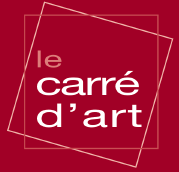 |
 Both artistic and pedagogical approaches underlie the way dance is taught at Le Carré d'Art: from their youngest age, the dancers undertake a “complete” expression that leads to a “multi” creation. The different learning stages are bound together, rigorous, but not restrictive: Introduction to movement, spatial discovery of the body, rhythm initiation, methodical learning of two techniques, ballet and contemporary, combinations at the barre and on the floor, free or thematic improvisations, active participation to the creation of a composition or a performance. Thus, dancing amounts to building a language, from a desire or an exigent creative reasoning. Students are then confronted to other disciplines: music, languages, theater, literature, art and cultural history. In about fifteen years, hundreds of dancers at le Carré d'Art have done research around themes such as the imposture of a Barbie, the ideal size of a shoe, the color of shadows or ties in game! * See ambroise perrin's report "rehearsal" |
 |
| Early learning and introduction to dance, ages 5 - 7 As they play, children discover that their body moves within space following certain rules and under certain constraints, but also spontaneously, which often surprises them; the teacher gets them to questions themselves about their impulsive reactions, and to exploit them in a system of codification common to all students. Children draw their inspiration from music in order to invent movements. The teacher also teaches them rhythm notions that will enable them to acquire the foundations for a future learning of the dance techniques. Their bodies hence become the vehicles of their imagination, and their imagination grows as they “read” into each other's bodies. * See ambroise perrin's report "initiation" Contemporary dance, ages 7 - 10 ballet Methodically learning these two indissociable dance techniques: “ballet” and “contemporary”; studying their “vocabulary”, their respective types of movements, in order for all children to be able to optimize, within their capabilities, the physical potential of their bodies. The two hour class is divided in two: a ballet part, with exercises at the barre, and a contemporary part, on the floor, with movements, combinations, and improvisations. Contemporary dance, ages 10 - teenagers and adults Every student, whether already initiated, made sensitive or only beginner, puts a lot into these classes, for the pleasure of combining rigor and enthusiasm and of quickly acquiring simulating results. These self-promises of personal progression reach their “apotheosis” at the final show to which all students of the school participate at the end of the year. The classes are usually structured as follows: floor barre, warm-up exercises: muscular isolation, stretching, tension, relaxation, body axes; standing exercises, movements, combinations: balance, supporting body part, direction within space, speed of movement; improvisations: continuous movement, suspended movement, gesture sentence, modifying and transforming it, sequence of movement, composition. * See ambroise perrin's report "continuation" Improvisation, all ages Practicing improvisation develops the dancers' imagination and creativity. The instantaneity of the movements leads them to go beyond their physical faculties and assert their unique personality, often in an impulsive manner. Through improvising under certain freely accepted constraints, or following thematic schemes, the dancers then gets to composition, this improbable alchemy that we also gladly call creation. * See ambroise perrin's report "perspiration" |
||


